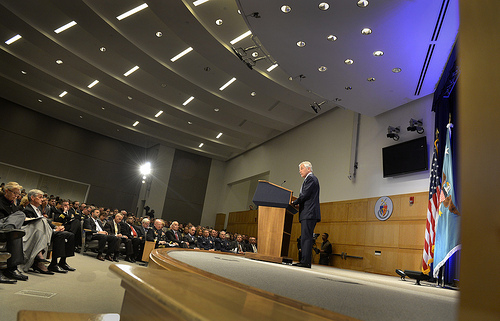
“A thorough examination of the way our military is organized and operates will…highlight our inherent strengths. Our strategic planning must emphasize these strengths, which include leader development, training, mobility and logistics, special operations forces, cyber, space, research and development.”
Speaking at Washington’s National Defense University (NDU) this week, US Secretary of Defense Chuck Hagel, who I have had the honor to meet as a member of the Strategic Advisors Group of the Atlantic Council, could have been any European minister of defense. With sequestration the US armed forces are now facing what has been a reality of European militaries for too many years – doing too much with too little for too long over too great a distance.
So, how can NATO address its most pressing emerging security challenge: how to close the strategy-austerity-capability gap?
The Alliance and its members have an as yet untapped capability too often overlooked – knowledge, education, and training. The fact that Hagel chose to deliver his realistic message about US defense strategy at NDU speaks volumes. Put simply, the more NATO militaries face capability and capacity cuts, the more the need to think creatively across narrow domains. That means quality NATO people. It also means a wholly new approach to professional military education and much greater synergy and cohesion between the defense academies across the Alliance who deliver both education and training (they are two sides of the same quality coin).
If I have a passion (apart from my wife and Sheffield United – I think in that order) it is professional military education. To my mind education, the knowledge it is built upon and the connectivity it breeds is the missing link between NATO nations that will help the Alliance close the strategy-austerity-capability gap.
NATO 2020 pre-supposes defense modernization at a time of acute defense austerity. NATO has created both Smart Defense and the Connected Forces Initiative both of which further pre-suppose much greater synergies between capabilities and capacities. Today, value for money in defense strategy is as much about ‘human software’ as hard capability. Therefore, critical to NATO 2020 must be a model of professional military education that aims to promote comparative advantage of NATO personnel both on and off the battlefield.
Such a goal will only be realized if a) lessons-learned are properly captured to ensure corporate memory is translated into best operational practice; b) exercising and training really tests weaknesses rather than confirms strengths and as such are scientific, rigorous, structured, and connected; and c) such lessons are communicated into the defense (and security) classroom. In other words NATO must become as much knowledge nexus as military nexus.
Thus far professional military education has been remarkably immune to the revolution in professional education that has taken place in other fields such as medicine and engineering. The knowledge base tends to look backward and little is made of life-long learning concepts to properly support mission success at every level of command in which and for which education and training are simply two sides of the same coin. Moreover, the link between commanders and academic expertise is too often weak, preventing effective reach-back from the field to knowledge communities (much of which can be explained by at times frankly ridiculous sensitivity over information). Sadly, too many commanders remain dismissive of knowledge and expertise.
However, defense academia has also to ask itself some searching questions. The research undertaken by defense academics too often either solves yesterday’s problems or has nothing whatsoever to do with the military challenges of today. And, too often the syllabus is narrow and fails to involve the wider security community. Finally, the revolution in technology that is changing education seems to have been only partially grasped by defense academics.
Therefore, in my own modest way I am trying to do something about it and putting the usual backs up in the usual places for daring to try. In May I will lead a project entitled Connected Forces, Connected Minds. This project will start to address some of the important issues raised in Hagel’s statement.
Knowledge transformation is the way ahead. To that best practice end new models of professional military education are needed and must be worked up in a new partnership between armed forces and defense academics. This is both to support NATO 2020 and all important strategic unity of effort and purpose in a rapidly destabilizing world. The goal must be clear; to continually enhance and develop the education and training of NATO (and Partner) officers so that a) in effect they never leave professional military education; and b) they are continually made fit for mission success in their next command challenge. Too often they are not.
Almost a year ago, NATO Secretary General Anders Fogh Rasmussen launched Smart Defense. There can be neither Smart Defense, Connected Forces, nor indeed NATO 2020, without smart education, smart training, and smart research.
Thank you, Mr. Secretary for being so clear and candid.
Julian Lindley-French is a member of the Atlantic Council’s Strategic Advisory Group. This essay first appeared on his personal blog, Lindley-French’s Blog Blast.
Photo credit: DoD/Glenn Fawcett
Image: 8616357161_c2da9cd7d2.jpg
